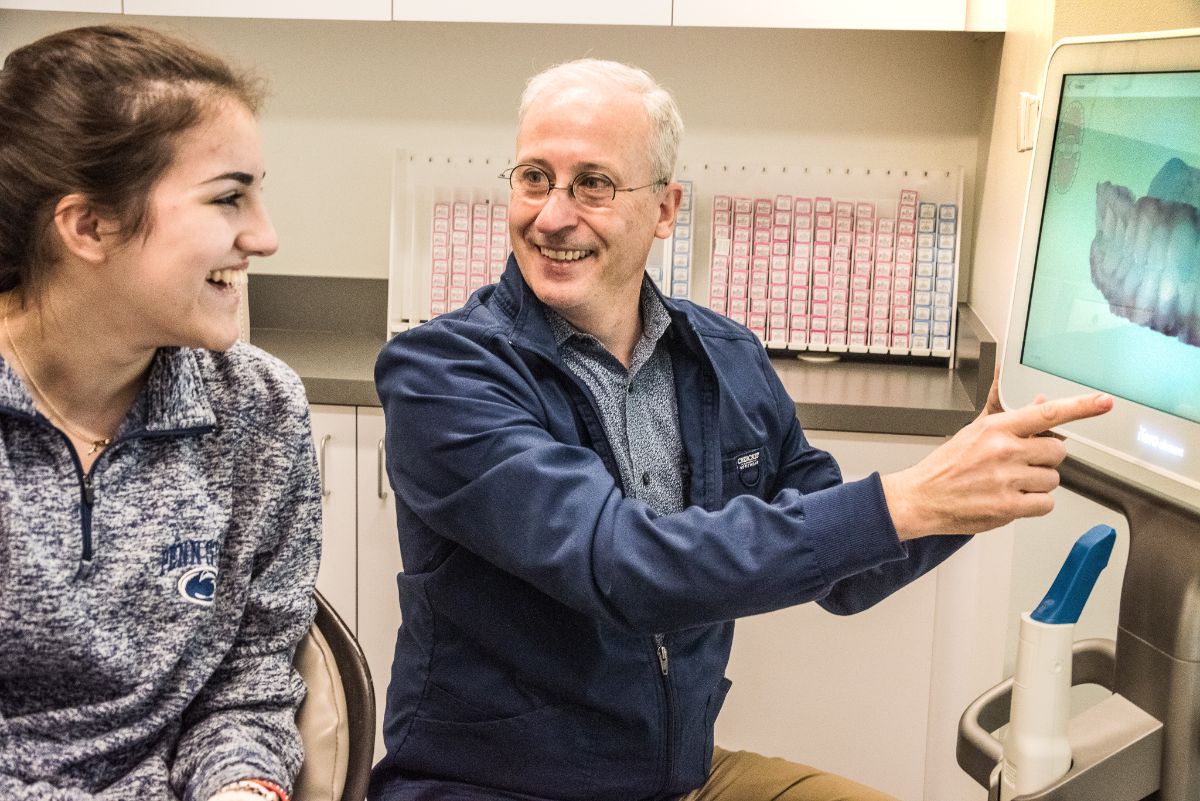Most parents will agree that putting a child in a sport is great for many reasons, developing social and motor skills, promoting regular exercise disguised as fun and even teaching some essential life skills like time management and the benefits of sticking with something. But as the parent, you are also tasked with more than just chauffeuring MVPs to practice and keeping water bottles full.
Your child’s dental health is a significant concern when the possibility of a ball or body part to the mouth increases with sports. Whether your child has metal braces, a retainer, or clear aligners like Invisalign, their mouth needs to be adequately protected to avoid painful injuries and permanent mouth damage.
Our doctors and experienced team at Howard Orthodontics have seen it all when it comes to cutting lips and broken appliances from sports-related injuries. While our patients probably won’t go through a real orthodontic emergency because they aren’t very common, we believe that avoiding tooth and mouth injuries in children while playing sports can be as simple as using protective gear like a mouthguard.
Sports and Dental Injuries
Sports-related dental injuries account for 40% of all dental injuries in the United States. You may think high-speed sports that involve a lot of contact and collision are the only concern for mouth injuries, but accidents happen all the time. A fall in a solo sport like skateboarding can result in a chipped tooth or broken bracket.
Howard Orthodontics patients can still play sports like usual during treatment but check your appliances and mouth immediately if you have an accident during your athletic activity. If the instruments appear damaged or the teeth loosened, schedule an appointment for repair as soon as possible.
When we evaluate and treat dental injuries, a quick assessment and early treatment is our primary goal. The most common injuries we see are tooth fractures, commonly referred to as a ‘chipped tooth,’ and soft tissue lacerations or cuts on your gums, tongue, or cheeks due to direct impact to or with the area. While inspecting for these types of injuries, we also check the motion of your jaw to address any jaw dislocation.
Some patients may experience a more profound oral injury such as luxation. A tooth may become displaced but still in the socket or even an avulsion in which the tooth becomes wholly dislocated.
Sports-Related Mouth Protection
According to a survey conducted by the American Association of Orthodontists, 99% of parents with children playing organized sports feel mouthguards should be required to play, but close to 40% of those parents said their child never wears one for practice or games.
Getting a kid to wear a mouthguard may seem as difficult as getting them to eat green vegetables. Still, it is one of the most inexpensive ways to protect your child’s teeth, tongue, gums, and cheeks from trauma during their extra-curricular activities.
Orofacial and dental injuries are a risk for participants of all ages, genders, and skill levels during organized and unorganized sports at both recreational and competitive levels. While most dental injuries are sustained during collision and contact sports, they are also prevalent in limited-contact, non-contact, and high-velocity activities.
Currently, the American Dental Association recommends the use of a properly fitting mouthguard in the following activities:
Contact/Collison Sports
- Basketball
- Boxing
- Combat Sports
- Football
- Handball
- Hockey (Ice and Field)
- Lacrosse
- Martial Arts
- Rugby
- Soccer
- Water Polo
- Wresting
Limited Contact and Other Sports
- Acrobatics
- Baseball
- Bicycling
- Equestrian Events
- Field Events
- Gymnastics
- Inline Skating
- Racquetball
- Shot-Putting
- Skateboarding
- Skiing
- Skydiving
- Softball
- Squash
- Surfing
- Volleyball
- Weightlifting
Choosing and Caring for your Mouthguards
As with any other decision made to keep your kids safe, there are plenty of options for mouthguards. Still, according to the ADA Council of Scientific Affairs and Council on Advocacy for Access and Prevention, an ideal mouthguard should:
- Be adequately fitted to the wearer’s mouth and accurately adapted to their oral structures
- Be made of resilient material approved by the FDA and cover all remaining teeth on one arch
- Stay in place comfortably and securely
- Be physiologically compatible with the wearer
- Be relatively easy to clean
- Have high-impact energy absorption to reduce or limit transmitted forces upon impact
If you are currently undergoing orthodontic treatment, consult with your orthodontist to ensure the mouthguard will fit over your appliances and not damage the device or harm your mouth if an impact occurs.
You will know you have a good fit if it is comfortable, offers adequate coverage, and doesn’t interfere with speaking or breathing. The three most common types of mouthguards are stock or pre-made, “Boil and Bite,” and custom-made. Take a look at the uses and differences below.
Pre-Made Mouthguards
The pre-made option is the most common mouthguard due to availability since it’s what you are likely to find in a sporting goods store. These mouthguards come in various sizes and colors to suit as many wearers as possible. The stock mouthguard is considered the least effective option because it has a generic design that is not adapted to any particular mouth giving an improper fit and requires the mouth to be shut to keep it in place.
“Boil-and-Bite” Mouthguards
Mouth-formed mouthguards are commonly referred to as “boil-and-bite” because they are designed to be warmed in water briefly to become permeable and then cooled slightly to be placed in the mouth and bitten down to create a customized fitting. These can also typically be found in sporting goods stores or ordered online. A dental professional may help facilitate the proper forming around dental appliances in some cases. Follow all manufacturer’s instructions precisely to ensure adequate heating and molding of the thermoplastic material, and avoid improper shaping creating a poorly fitted device with diminished protection.
Custom-made Mouthguards
Custom mouthguards are fabricated in a dental office or lab from individual patient impressions using thermoforming techniques to be fully customized and provide wearers the best fit to adapt to your mouth while still being the most effective. While this is often the most expensive option for oral protection, the balanced occlusion and maximized tooth contact significantly reduce the risk of the mouthguard becoming displaced during high-impact activity.
Orthodontic Emergencies
There will likely come a time when your active kid falls victim to their first sports-related dental injury. Remember to stay calm and carefully examine the damage to be explained to the dental professional. Next, contact Dr. Eric Howard for specific instructions on mitigating your injury until they see you in the office. Here are some of the more common injuries we see and how to handle them best.
Fractured Tooth
A fractured tooth is often far scarier than the reality of the experience. To stabilize the broken or chipped tooth and control any bleeding, you can bite gently on a towel as you head to your dentist. If the tooth piece has completely come out of the mouth, it can be transported in milk, under your tongue, or wrapped in saline-soaked gauze.
Missing Tooth
If the whole tooth has come out of the socket, do not touch the roots and pick the tooth up by the crown. Gently rinse it in water and place the tooth back into the socket it came from, gently biting down on a towel to hold it in place as you head to the emergency dentist. As unbelievable as it may seem, a tooth placed back into the socket within 5 minutes of ejection can be permanently saved.
Extruded or Laterally Displaced Tooth
This injury will look like a tooth is longer than usual and often appears with the displaced tooth being pushed back or pulled forward. To reposition this tooth, firm but precise pressure is needed, and this process is most effectively performed by a dental professional.
Intruded Tooth
If the tooth looks like it is now shorter than usual, it has likely pushed into the bone and become intruded. An intruded tooth is a painful experience and requires an immediate visit to an emergency dentist. Do not attempt to pull the tooth out or reposition the tooth.
While these are the most common dental emergencies children in sports are likely to face, these are not all possibilities. Make sure you get to your dentist as soon as possible after an injury. Your dentist or orthodontist can completely remedy many mouth injuries caught in the first couple of hours without risk of permanent damage. But, if your child develops a fever, has trouble breathing or swallowing, or their bleeding doesn’t stop after about ten minutes of pressure, it could be a more serious concern, and you should go to the closest emergency room.
Trust your Kid’s Oral Health and Safety to Howard Orthodontics
At Howard Orthodontics, we’re passionate about providing high-quality orthodontic care to patients in all sports and activities in the Willow Street, PA, area. While you’re in for your consultation or check-up, let us know about the sports your child is playing, and we can get you the information to help you pick the mouthguard that will fit your child’s mouth and needs best.
Dr. Howard and his friendly team are standing by with the education and experience you need to reach the smile of your dreams without giving up the sport you love. Schedule a FREE consultation today to get your custom mouth protection for prolonged oral health!


